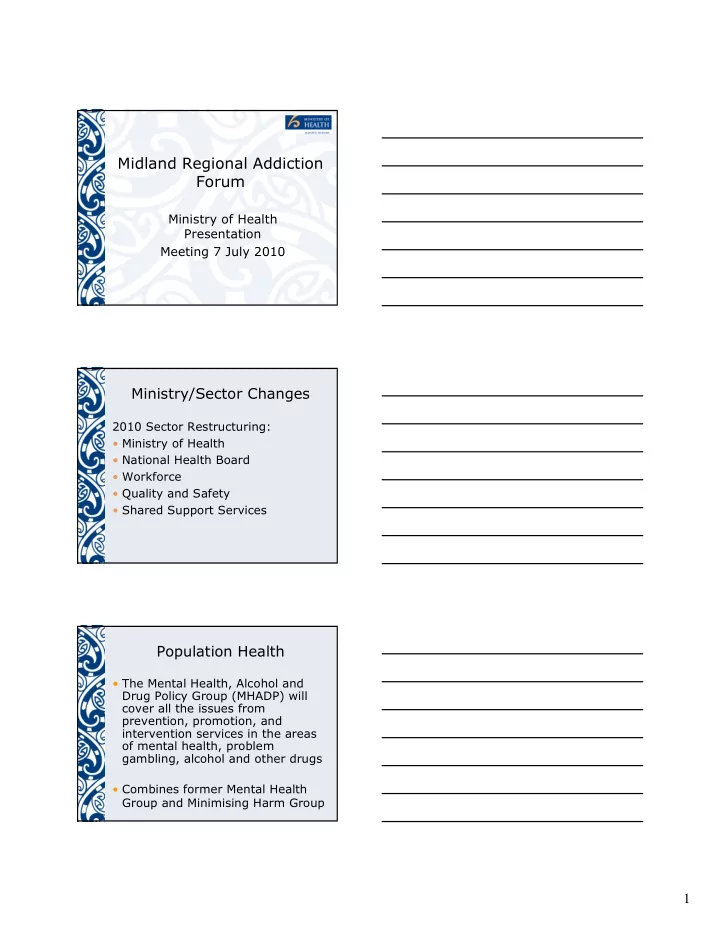

Midland�Regional�Addiction� Forum Ministry�of�Health� Presentation Meeting�7�July�2010 Ministry/Sector�Changes 2010�Sector�Restructuring: • Ministry�of�Health� • National�Health�Board� • Workforce� • Quality�and�Safety� • Shared�Support�Services Population�Health • The�Mental�Health,�Alcohol�and� Drug�Policy�Group�(MHADP)�will� cover�all�the�issues�from� prevention,�promotion,�and� intervention�services�in�the�areas� of�mental�health,�problem� gambling,�alcohol�and�other�drugs • Combines�former�Mental�Health� Group�and�Minimising Harm�Group 1
Mental�Health,�Alcohol�and�Drug� Policy • National�Drug�Policy • Problem�Gambling • Addiction�Treatment�Services • Mental�Health�Policy • Mental�Health�Programme Development • Mental�Health�Protection • Office�of�the�Director�of�Mental� Health Functions The�Group�will�have�functions�for:� • Policy�development�including�overview� and�evaluation�of�the�impact�of�mental� health,�alcohol�and�drug�policy� implementation� • Responsibility�for�regulatory�and� legislative�frameworks� • Provide�national�leadership�to�the� mental�health,�addiction,�drug�and� alcohol�sectors • Funding�functions�to�be�aligned�with� NHB Drivers�of�Crime • Launched�by�Hon�Simon�Power,�Minister� of�Justice�and�Hon�Pita�Sharples,� Minister�of�Māori Affairs • A�new�approach�to�dealing�with� offending�and�victimisation • Means�getting�serious�with�how�to�stop� crime�from�happening� • Shifts�response�from�after�crime�has� happened 2
Drivers�of�Crime�Meeting�3�April� 2009 • Over�100�invited�only�attendees • Included�those�at�the�frontline�of�� offending�prevention�and�intervention,� researchers�and�academics,�MPs,�and� officials • Keynote�presenter�was�Professor�Richie Poulton • Agenda�set�to�discuss�identifying� drivers�of�crime�– addressing�them�to� come�later • Ministry�of�Justice�to�lead�response Address�by�Richie Poulton What�can�the�evidence�tell�us? • Nature�vs nurture�debate�is�dead • While�genes�may�play�a�part,�the�most� important�factor�is�the�environment • It�is�the�combined�effects�of�multiple� adversities�that�drives�criminal� behaviour Developmental�Pathways�to� Antisocial�Behaviour Two�major�pathways�to�crime: • First�group�display�antisocial�behaviour very�early�in�life�– this�behaviour persists�and�generally�worsens�as�they� get�older • Other�much�larger�group�starts� antisocial�behaviour in�adolesence,�is� typically�influenced�by�peers,�and� generally�stops�in�early�adulthood 3
Bad�Behaviour =�Bad�Outcomes • Antisocial�behaviour that�starts�early�in� life�and�persists�over�time�is�not�only� associated�with�poor�mental�health,�bad� relationships,�and�criminal�behaviour,� but�also�with�a�wide�range�of�physical� health�problems • The�child�abuse�and�domestic�violence� we�are�concerned�about�is�perpetrated� by�individuals�who�have�shown� antisocial�behaviour since�childhood • It�is�possible�to�identify�them�early�in� life The�Implications�of�Intervention • Interventions�must�be�tailored� specifically�to�each�of�these�two�groups� to�be�effective • For�early�on=set,�must�be�as�early�as� possible,�for�both�child�and�family • For�adolescent�onset,�must�be�at� individual�level,�given�that�behaviour is� driven�by�peer�influence�– group� intervention,�including�prison,�is�the� worst�possible�response Summary�of�Discussion�by� Participants • No�one�simple�answer • Involves�interplay�between�family,� community,�educational�environments • Issues�of�alcohol,�drug�use�and�the� justice�system�response�further� exacerbate�situation 4
Family,�Community�and� Education�Environments • Poor�parenting,�poor�education� attachment�and�disconnectedness�from� wider�society�contribute�to�crime • These�issues�more�concentrated�in� some�communities • Transferred�across�generations�within� some�families Underlying�Drivers�of�Crime� • Same�for�Māori and�non=Māori • Prevalence�of�some�risk�factors�such�as� poverty,�transience,�young�mothers,� sole�parent�families�tends�to�be�higher� for�Māori • Appropriate�responses�may�need�to�be� different�for�Māori,�including�giving� Maori�ownership�and�voice�in�the� development�of�responses�taking� whānau concepts�into�account�and� building�resilience Two�Other�Influences While�not�drivers�of�crime,�these�factors� influence�responses�to�any�of�the� drivers • How�the�reporting�of�crime�in�the�media� affects�the�public�perception�of�crime • How�Government�policies�are�often� fragmented�and�lack�commitment�to� longer�term�approaches 5
Alcohol • Discussed�by�most�groups�as�a� contributor�or�facilitator�to�crime,�rather� than�a�driver • Lowering�the�age�limit�has�opened� access�to�even�younger�individuals • Increasing�numbers�of�liquor�outlets,� particularly�in�marginalised &�vulnerable� communities • Perceived�lack�of�AOD�treatment Other�General�Discussion • Many�of�the�issues�in�service�provision�are� around�transitions�between�services�and� stages:�between�schools,�from�kohanga to� mainstream,�from�prison�to�community,� between�agencies • Mental�Health�issues�and�crime�– maternal� mental�health,�undiagnosed�mental�health� issues�in�young�people,�the�role�of�the�justice� system�in�dealing�with�the�effects�of�mental� illness,�and�the�use�of�prisons�to�house� mentally�ill • Value�for�money�in�government�funding�– need�to�be�cost�effective,�stop�funding�what� doesn’t�work Progress�to�Date Four�Work�Streams�Established:� • Improving�the�quantity,�quality�and� effectiveness�of�maternity�and�early� parenting�support�services,�particularly�for� those�most�at�risk • Addressing�conduct�and�behavioural problems�in�childhood • Reducing�the�harm�from�alcohol,�and� improving�the�availability�and�accessibility� of�AOD�treatment�services • Identifying�alternative�approaches�to� manage�low=level�repeat�offenders�and� offering�pathways�to�success� 6
Common�Themes�to�Date • Need�to�take�a�more�client=driven� approach�to�government�service� delivery� • Includes�changing�the�way�that� services�are�contracted�and�delivered� so�that�they�are�better�integrated�and� more�responsive�to�individual,�family�/� whānau and�community�needs • Examples�of�relevant�developments� include:�Whānau Ora;�Better,�Sooner,� More�Convenient�Primary�Health�Care;� and�Integrated�Service�Response�/� Community�Link� Next�6�months�for�Drivers�of� Crime Focus�will�be�on: • Continuing�the�implementation�of� solutions�that�are�already�underway;� • Completing�the�design�of�further� solutions�to�address�identified�issues� and�barriers;�and • Continuing�to�work�on�the�significant� challenge�of�improving�outcomes�for� Māori.� Solutions • Some�solutions�involve�relatively� minor�changes�to�existing�policy�and� programmes,�e.g.�improving�skills�and� capacity�in�non=health�sector�agencies� to�address�low�level�alcohol�problems�� • Other�solutions�involve�substantive� changes�to�current�legislation�and� policy�settings�(e.g.�sale�and�supply�of� liquor)�and�expansion�of�services�(e.g.� services�to�address�conduct�and� behaviour problems)� 7
Working�Together�in�a�New� World�Workshop For�Justice�Sector�= • Identify�current�level�of�access • Understand�CJS�clients�treatment� needs • Identify�future�demand • Understand�barriers�to�treatment • Develop�evidence Workshop�Question • What�is�the�demand�for�your�services� from�CJS�– some�many�most�all • Is�the�AOD�treatment�needed�for�CJS� clients�different�from�other�peoples,�if� so�how? • What�is�your�relationship�like�with� Courts,�Probation,�Police,�Parole�Board� – what�works/�what�doesn’t? • Aware�there�are�challenges,�barriers,� but�what�are�the�solutions? 8
Recommend
More recommend